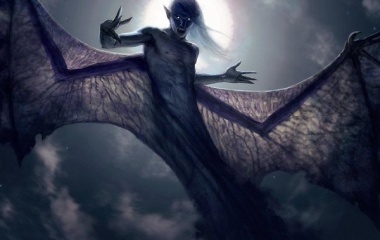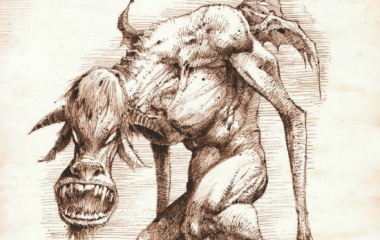The terrifying Aswang is the most feared creature of Philippine folklore—and with good reason. Stalking its prey in the small, rural towns of the Philippines, the Aswang nocturnally hunts for a meal of human flesh and blood.
What is an Aswang?
The Aswang (æ·swang) is a flesh-eating, shapeshifting monster. During the day, they appear as regular townspeople, though they may be observed by others to have reclusive habits or magical abilities. At night, they shift into eerie predatory forms and go hunting for human prey, preferring to feast on children and pregnant women above all else.
Characteristics
Physical Description
Varying horrible descriptions have been given of the this monster’s appearance, but some recurrent traits stand out among all the different descriptions. Usually, they are women during the day. At night, however, they may appear as birds, pigs, or dogs.
No matter which animal form it takes, an Aswang will differ from a regular animal in various disturbing ways. Most have long, proboscis-like tongues, and are frequently described as walking with their feet backward. They have also been depicted as being so thin that they can hide behind bamboo posts.
Special Abilities
The Aswang’s most fearsome ability is its knack for blending in with its victims. During the day, they look and act just like regular people. Although they are generally shy and somewhat reclusive, they can have jobs, friends, and even families.
During the night, Aswangs shift into a form that is better suited to hunting. Different regional versions are said to take different forms. The tik-tik and wak-wak become large birds, while the zegben (sometimes described merely as a companion of the Aswang) takes on the form of a Tasmanian devil. They have also been reported shifting into pigs and dogs.
In addition to shapeshifting, Aswangs also have the ability to transform the appearance of other objects. It’s common for these flesh-eaters to transform plant material into doppelgangers of victims, in order to hide the evidence of their feeding habits from locals. These doppelgangers might replace corpses, which the monsters often consume, or they might replace living people. If the doppelganger replaces a living person, it will return to the person’s home, get sick, and quickly die.
Another tactic Aswangs use to disguise themselves is to use sinister vocal tricks. As they gets closer to their victim, their calls get quieter and quieter, so the victim is tricked into thinking the predator is actually getting further away.
The Aswang’s hunting prowess is almost as frightening as its ability to hide itself in plain sight. They like to dine on corpses, fetuses, and small children, and They often appear at funeral wakes or at the bedside of pregnant women to eat, using theit proboscis like tongues to suck blood from their victims or suck a fetus from a pregnant woman’s womb. They also have superhuman strength during the nighttime.
A person transforms into an Aswang by tying a fertilized chicken egg to his or her stomach. After some time, the chick passes from the egg into the stomach. Once this has happened, the remaining eggshell is buried in a bamboo tube, along with coconut oil and chicken dung. The person now has the powers of an Aswang.
A dying Aswang can also pass its powers along to someone else if it wishes. The Aswang holds its mouth close to a chosen person, and the chick inside the monster’s stomach hops into the mouth of the chosen one.
Weaknesses
The first step towards ridding a town of an Aswang is identifying the monster. There are several ways in which you can do this. They generally have bloodshot eyes, since they have been awake hunting all night. In addition, it is said that if you look directly into their eyes, your reflection will appear upside-down. The most common method of detecting Aswangs, however, involves using albularyos oil, a special oil made of coconuts and holy plants. This oil is said to boil whenever an Aswang is near.
Aswangs are repelled by garlic and religious artifacts and are at their weakest during the day, when they are in human form. They can be killed by decapitation or by being struck with a whip made from a sting ray’s tail.
Related Creatures
The Aswang has a lot in common with western vampires, but there is no evidence to show that either creature inspired the creation of the other. Stories of the Aswang and of vampires probably evolved separately.
Other monsters in Philippine folklore are more likely to be related.
Both the wak-wak version of the Aswang and the manananggals, a different monster, leave behind half of their human torso when they transform into a predatory form during the night.
Aswangs also have connections to witchcraft in the Philippines. and They are generally described as women, and they are sometimes said to have magical powers during the day. While they are generally to be feared, they are sometimes said to provide healing potions or to cast spells for local people.
Cultural Representation
Origin
The Aswang was born out of Philippine folklore, with stories of this terrifying creature dating back to at least the 16th century, when Spanish explorers created the first written record of monster. The explorers noted that of all the monsters in their folklore, the Aswang was the most feared by native people.
The word Aswang comes from the Sanskrit word “asura,” which means demon. The monster is also sometimes called the tik-tik or the wak-wak. These names come from the sinister sounds the monster is said to make while hunting.
Famous Myths
Despite the fact that belief in this monstrous creature has spread throughout the Philippines, there aren’t many well-known individual stories about the Aswang.. Instead, the monster’s fame is built on a collection of firsthand encounters, and almost everyone who claims to have had an encounter has a slightly different report.
The creature’s mythology was formalized in the 1960s, when Maximo Ramos included a description of the terrifying flesh-eater in a book titled Creatures of Philippine Lower Mythology.
Visual Arts
Drawings of the Aswang have populated Philippine folk art for centuries. Since its introduction to western culture, the monster has also begun to make appearances in western art.
The Aswang Inquiry, an illustrated book by Gilda Cordero-Fernando, contains many paintings of the monster. Stage plays have also brought Aswang mythology into the spotlight, with Luna: an Aswang Romance and Tiktik: the Aswang Chronicles both showcasing the monster.
Most recently, a documentary called The Aswang Phenomenon explored the evolution of the mythology and the culture behind the myths.
Explanations of the Myth
As fantastic as stories of the Aswang might seem, they may actually have been inspired by real life events.
One theory is that native wildlife was the inspiration for the legends. The “tik tik” and “wak wak” hunting calls the Aswang is said to make are probably the calls of nocturnal birds. Bats, Tasmanian devils, and kagwang, an endangered species of flying lemur, have all been killed because they have been suspected of being Aswang in a transformed state.
Another possible explanation is the presence of a rare genetic disease called XDP, which almost exclusively affects Filipino men. XDP causes patients to have Parkinsonian and dystonic symptoms; the patient is afflicted with uncontrollable muscle spasms, contortions, and tremors. Images of the Aswang during transformation are strikingly similar to photographs of a patient experiencing XDP symptoms. The highest concentration of XDP occurrences is in the Capiz region, which is rumored to be the original home of the Aswang.
Finally, the legend may be used to explain away horrendous, unsolved crimes in the Philippines. When a person disappears or is brutally murdered, it may be easier for local people to attribute the crime to a demon rather than to one of their fellow humans. Tabloids often attribute crimes to Aswangs, which adds fuel to the mythology.
Aswang






No comments:
Post a Comment